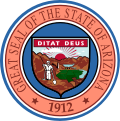Important dates in Arizona's history |
|---|
|
| History of Arizona |
|---|
 |
| Periods |
|
| Topics |
| Places |


The following is a timeline of the history of the area which today comprises the U.S. state of Arizona . Situated in the desert southwest, for millennia the area was home to a series of Pre-Columbian peoples. By 1 AD, the dominant groups in the area were the Hohokam, the Mogollon, and the Ancestral Puebloans (also known as the Anasazi). The Hohokam dominated the center of the area which is now Arizona, the Mogollon the southeast, and the Puebloans the north and northeast. As these cultures disappeared between 1000 and 1400 AD, other Indian groups settled in Arizona. These tribes included the Navajo, Apache, Southern Paiute, Hopi, Yavapai, Akimel O'odham, and the Tohono O'odham.
Contents
- Pre-Columbian and Spanish eras
- Pre-Columbian
- Arrival of the Spanish
- U.S. possession and territory
- 1840s
- 1850s
- 1860s
- 1870s
- 1880s
- 1890s
- 1900–09
- 1910s
- Statehood through World War II
- 1910s, continued
- 1920s
- 1930s
- 1940s
- Post-war years through the 1960s
- 1940s, continued
- 1950s
- 1960s
- 1970s through the end of the millennium
- 1970s
- 1980s
- 1990s
- 21st century
- 2000–09
- 2010s
- See also
- References
- Bibliography
- Further reading
- External links
The first European presence in the state were the Spanish. In 1539 Marcos de Niza explored the area, followed by Francisco Vásquez de Coronado the following year. Spanish missionaries began to settle in the southern portion of the state, near present-day Tucson, around 1700, but did not move further north. With the construction of the Presidio San Augustin del Tucson, on August 20, 1775, Tucson became the first European city in what would become Arizona. In 1822, Arizona became part of the state of Sonora, Mexico, but most of current Arizona was transferred to the United States as a result of the Mexican–American War, with the rest transferring with the completion of the Gadsden Purchase in 1853. During the American Civil War, both sides laid claim to Arizona, although the North and South split the New Mexico/Arizona area differently: the South split the territory into north and south divisions, creating Confederate Arizona, while the northern section remained part of the United States as the New Mexico Territory; while the North in 1863, after driving Confederate forces from the Tucson area, created the Arizona Territory from the New Mexico Territory by splitting off the western section. Prescott became the territory's first capital, which would transfer to Tucson in 1867, then back to Prescott in 1877, before settling finally in Phoenix in 1889.
Arizona achieved statehood in 1912, becoming the 48th state, with Phoenix remaining the capital of the new state. In the 1900s, the state, particularly the Phoenix Metropolitan area, has seen tremendous population growth. Phoenix currently ranks as the 6th most populous city in the nation.

